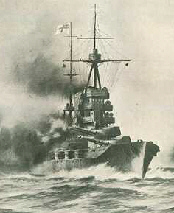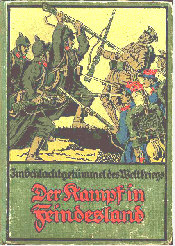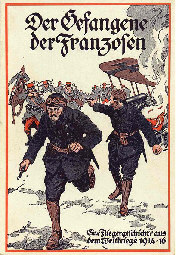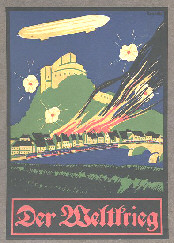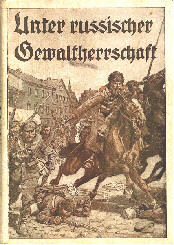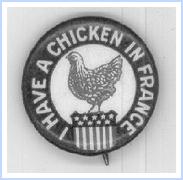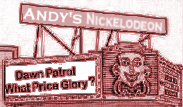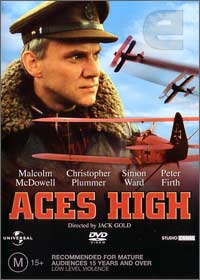
May 2006 |
Access Archives |
TRENCH REPORT: Congrats to near-deadheat responders Ken Reibel of Milwaukee and Tom Clegg of Uniondale, Iowa for successfully identifying Raymond Loewy, legendary industrial designer and former Engineering Officer with the French Army as the designer of all those corporate logos. I'm temporarily suspending the trivia contest, though; we had 14 correct responses within an hour of my posting the page. I need to find some tougher questions for our well-informed readers. . .I did a web search this past month to discover which other internet websites are recommending at least one of our family of websites. (list & hyperlinks) Out of the thousands of "hits" here are some our strongest "fans": US Army Historical Foundation, BBC, British National Archives, Family Tree Magazine, Ancestry.com, Best of History Web Sites, PBS, Social Studies School Service, Historycentral.com, Military.com, History Matters, Historyteacher.net, Rutgers University Web Guide, About.com, Teaching American History. A big THANK-YOU to all these sites for their support. . .I'll be leading a group to the Western Front in May for Valor Tours. Look for some photos and battlefield updates in future issues. Late News Flash! The San Francisco Giants baseball club has just installed a replica of the Memorial Plaque to WWI victim and team veteran, Capt. Eddie Grant. More next month. (Click here if you haven't been following this story.)
MH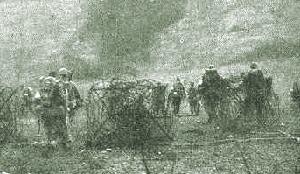 German Assault at VerdunThank Heaven for American Heritage
For decades American Heritage Magazine has regularly featured articles on the Great War. Recently, they seem to have opened their archives. Here is a selection of some of their best material from some renowned writers. You can search for others at their homepage. Best of all, these are available free. [At least for now.] 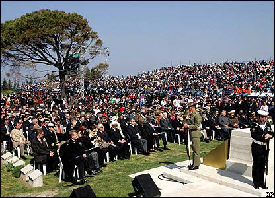 Huge Crowd at Lone Pine Monument |
|||||||||||||||||||
New at the Websites of the Great War Society and Our FriendsClick on Title to Access | |
At Great War Society Sites
At the WFA-USA
|

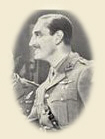 |
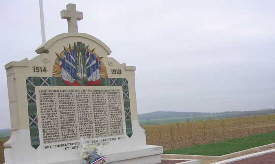
Marne Battlefield at Villeroy
I'll Be Reporting From Here Next Month
GREAT WAR 2006 EVENT CALENDAR | |
|
90th Commemorative Events Comprehensive Double Calendar Scheduled Throughout 2006 (link) | |
|
Aurora, Colorado May 19-21 (link) | |
|
Hilton Garden Inn, Tampa North August 16 (link) | |
|
Hartford Connecticut Contact Lannie Liggera for details (email) November 11th | |
|
An International View of the Great War With our Friends Jean- Pierre & Cecile Mouraux Sonoma, California Check back for Details November 11th | |
|
Email Response |
|
|
Trip-Wire Television Alert: Your editor and several of our website contributors--Len Shurtleff, Tom Fleming, BG Bob Doughty--appear as commentators on the History Channel production DECLASSIFIED: WORLD WAR I. The program premieres on May 4th at 10pm Eastern and will be reshown at assorted times afterwards. Check your cable listings.
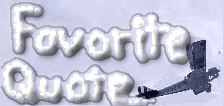
There seems to be something wrong with our bloody ships today.
Admiral David Beatty at Jutland
May 31, 1916
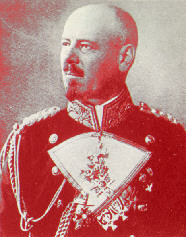
Adm. Franz von Hipper
Beatty's Battle Cruiser Opponent
At Jutland
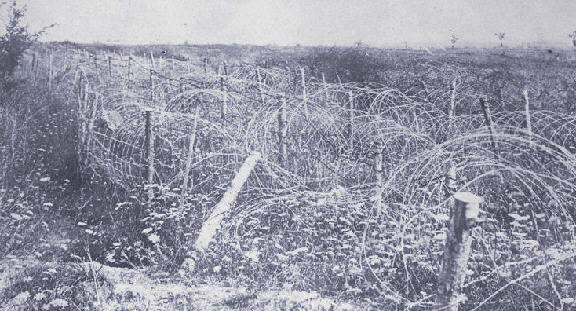
German Chaveaux de Frise Barrier
Anti-Cavalry and Possibly Intended to be Anti-Tank Obstacle
 |
First World War Titles |
|
·
Lejeune: A Marine's Life, 1867-1942 by
Merrill Bartlett ·
General of the Army: George C. Marshall, Soldier and Statesman by
Ed Cray ·
Patton: A Genius for War by
Carlo D'Este ·
The General by
C.S. Forester ·
Knight's Cross: A Life of Field Marshall Erwin Rommel by
David Fraser ·
Price of Glory: Verdun 1916 by
Alistair Horne ·
The Face of Battle by
John Keegan |
·
The Price of Admiralty: The Evolution of Naval Warfare by
John Keegan ·
The Rise and Fall of the Great Powers. . . by
Paul Kennedy ·
Reminiscences of a Marine by
John Lejeune ·
Changes in the German Tactical Doctrine During the First World War by
Timothy Lupfer ·
Reminiscences by
Douglas MacArthur ·
The Middle Parts of Fortune: Somme and Ancre, 1916 by
Frederic Manning ·
Gallipoli by
Alan Moorehead |
·
Once an Eagle by
Anton Myer ·
[Infantry] Attacks by
Erwin Rommel ·
Fall of Eagles by
C.L. Sulzberg ·
Fix Bayonets! by
John Thomason ·
The Killing Ground: The British Army, The Western Front & Modern
Warfare by
Tim Travers ·
How the War was Won by
Tim Travers ·
Pershing, General of the Armies by
Douglas Smythe ·
Infantry in Battle (U.S.)
Infantry School |
|
Verdun |
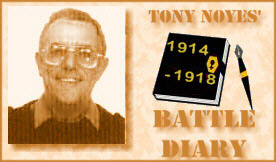 |
The Somme | |
May was the month of the disaster inside the German occupied Fort Douaumont and the subsequent French counterattack; and also the month of the coming of the Lafayette Escadrille.Click Here to See a Large
|
|||
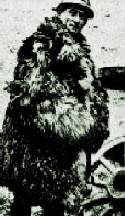 Composer Maurice Ravel Drove at Verdun |
But American pilots flying in action for France were definitely glamorous to the world of the American newspapers and the Lafayette Escadrille was rapidly transferred from Alsace to Verdun and scored their first victory in late May. It was about this time that the French Air Force began to realise that one photo-reconnaisance plane, suitably escorted by many fighters, could bring back priceless information in a short time and thus was born the beginnings of flying in specific groups to perform a specific task.
On May 8th Fort Douaumont suffered a internal grievous explosion. (article). This disaster did not pass unnoticed by the French who saw the mushroom cloud rising and they gradually realised that here was their chance to attack and take back the fort. It took them two weeks to prepare for and to launch their attack bringing up new heavy mortars and an increasing selection of artillery. This preparation was, of course, seen by the Germans and they also prepared for a counter artillery duel. On the 22nd the French assaulted this looming monster on the skyline and for a time it almost seemed they might be successful.
But the Germans won the day, the French were decimated despite appalling German losses, and the attack faded away. There were no reserves to fill the front lines vacated by the attacking French. At this point in time, if the Germans had had infantry in support in sufficient numbers, they could have advanced through the gap in the French lines and attempted to take Verdun. They didn't, and this gives rise to one of the great "what if" questions of the Great War. Could Verdun have been taken on this day?
By this time both Petain and Crown Prince William on their opposing sides seemed to know that the battle had acquired a life and momentum of its own and it is unlikely that the French artillery would have allowed such an eventuality. But the moment passed and the Germans continued with their plan to take Fort Vaux standing on the next ridge in plain sight of Fort Douaumont. It had been a long standing barrier to their original plans.
Click Here to See a Large
Battlefield Map of the Somme
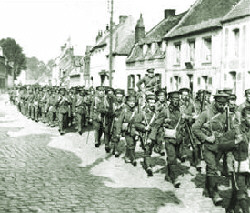
New Tommies
Marching to the Front
And the train stopped eventually and they got out and fell in in ranks and waited for orders. They marched in files of four, being jostled by wheeled transport moving in both directions on the pave roads and which claimed absolute right of way. They moved into their last ramshackle camp before the trenches.
If lucky, they were sent to a quiet part of the line and went "up the line" in small groups to become acclimatized to the darkness, the smell, the primitive latrines, the bad food, and the unending work of keeping their trench in good order. If unlucky, parading in the late evening, they went straight into the line after dark, taking over from the outgoing unit who departed quickly with comments not likely to calm the nerves of the newcomers.
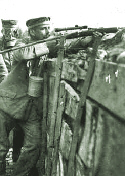 German Sniper |

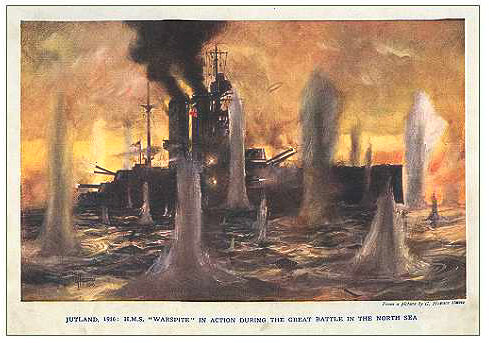
HMS Warspite Received More "Hits" Than Any Ship at Jutland
Survived to Serve on D-Day at Normandy, 28 Years Later
 |
André Maginot, Verdun and
The Maginot Line
By Christina Holstein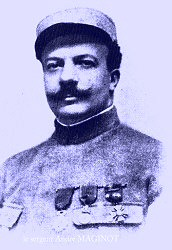 |
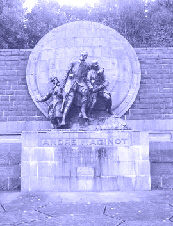 |
Text by Permission from Christina's book Fort Douaumont hereby recommended. (order)
|
in the 21st Century |
- Three Men Fallen at Ypres Found
- Exact Locale of Sgt. York's Feat Identified:
- Anzac Day Remembered Across the Globe
- Great War Mental Casualties Were Hidden
|
|
|
Click on the icon below to visit her site. |

|
Kinmell Park 1919, Part II |
Our editor has forwarded to me the comments of Trip-Wire reader Bill Jenkins on my article in the December 2005 issue titled: "The Kinmel Park Mutiny of 1919." (link) Mr. Jenkins was concerned that we may have left the impression that some or all of the men who perished in the incident were shot for mutiny.
The facts as far as I understand them are that five Canadian soldiers did die during the incident from gun shot and bayonet wounds. My understanding is that these five men were never judged or found guilty of any crime. Their deaths did occur when what is commonly referred to as the "The Mutiny at Kinmell Park" was taking place. There was, however, never any question of the loyalty or patriotism of any of the men stationed at the camp. They just wanted to go home and the continued delays built up a frustration that manifested itself in a riot.
Over the years a myth has arisen that many of the Canadians buried in this churchyard were mutineers, when the facts are that all but these five died from natural causes and rampant influenza. Of course it is more sensational to repeat the myth than find out the truth. Our use of "Mutiny" in the original article probably compounded matters. Although there is probably no intent to mislead, the official records were sealed for 100 years leaving the story open to interpretation. Below is the grave marker for one of the men who perished during the incident
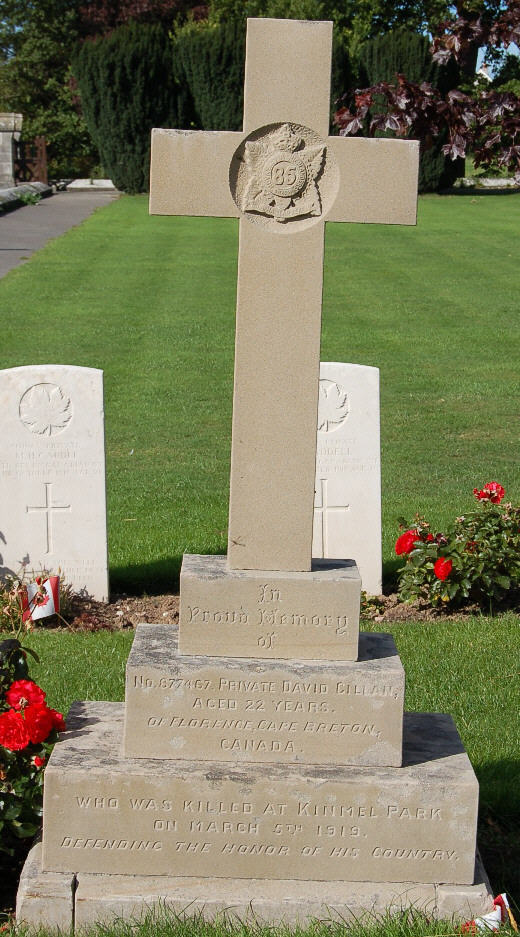
A trio of World War I films about the air war on the Western Front appeared between 1966 and 1976, The Blue Max (1966), Von Richthofen and Brown (The Red Baron, UK title) (1971) and Aces High (1976).
After a brief prologue in October 1916 at a public school (with a nice cameo by John Gielgud as Headmaster), Aces High covers a week in October 1917 with 76 Squadron RFC. 2nd Lieutenant Croft (Peter Firth) arrives as a replacement pilot to the dismay of Major Gresham (Malcolm McDowell). Croft has 15 hours of training with 4 of them on SE5s. He's wrangled his assignment to Gresham's squadron because Gresham is his idol and former public school house captain. Gresham is also involved with Croft's sister. But Gresham is no longer the beaming war hero who spoke at school about "caning" the Germans. He's now a commander who's lost too many friends and comrades and needs a belly full of liquor to fly in combat. Other flyers encountered by Croft include 'Uncle' Sinclair (Christopher Plummer) the squadron's reconnaissance pilot and Crawford (Simon Ward) a pilot at the end of his tether who will no longer fly combat, claiming neuralgia. Sinclair takes the young pilot under his wing, providing the avuncular companionship of an older and wiser man. Crawford is strained to the breaking point and cannot accept Croft. Eventually he confides to Croft his desire to desert. 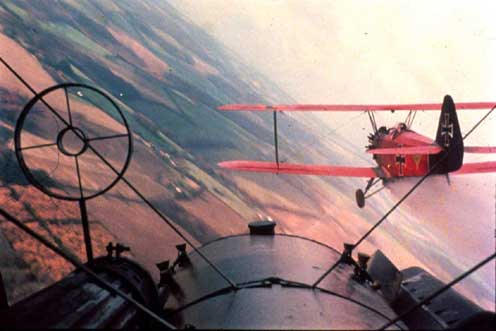 Still from the FilmThe mainly male cast gives strong performances. Besides McDowell, Plummer, Ward, Firth and Gielgud, there are also appearances by Tim Piggott-Smith (The Jewel in the Crown) and cameos by Trevor Howard, Ray Milland and Richard Johnson as upper staff officers. The aerial cinematography is excellent with the World War I aircraft represented by both replicas and actual period aircraft. As a cost savings some footage from both The Blue Max and Von Richthofen and Brown is used in several scenes. Barker's script combines the original tension in Sheriff's play of men facing fierce odds and losing comrades with actual wartime occurrences from Lewis's writings to create a vivid aviation story. Aces High is not available on DVD here in the States. I purchased my UK copy on-line. It's a bare-bones release without a trailer or production notes. The print appears a little faded in part and there is some noticeable print damage visible in one scene. But it is in a 19 X 9 wide-screen format and chances are it will not be going through a restoration anytime soon. Andrew Melomet, Proprietor of Andy's Nickelodeon will answer your Great War film or video inquiry. He is also soliciting your recommendations for the WWI Filmography he is compiling for our readers. Just click HERE. |
| The following are thanked for their contributions to this issue of the Trip Wire:Ed Warner, Sidney Clark, Christina Holstein, Bob Denison, Bob Ford, Tony Noyes, Esther MacCallum-Stewart, Andy Melomet, Len Shurtleff. [Sorry I lost the full list for this issue.] Until next month, your editor, Mike Hanlon. |
Membership Information  Click on Icon |
SUBSCRIBE TO THE TRIP-WIRE (Or Send it to a friend.) (Or send us a comment on the TRIP-WIRE) CLICK HERE TO CONTACT US VIA EMAIL |
For further information on the events of 1914-1918
visit the Directory Page of |

